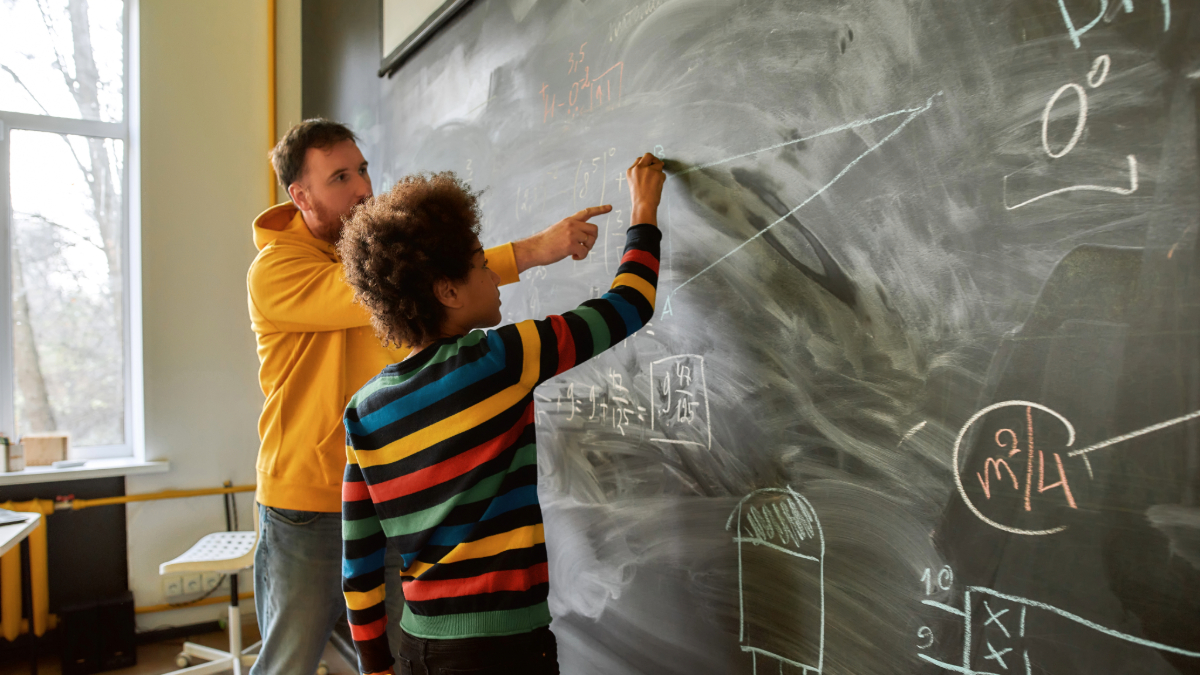Research Spotlight: Jessica Namkung

University of Delaware’s Jessica Namkung studies the nature of math anxiety among sixth graders and how it affects their performance in mathematics
“How do I multiply fractions again? How much time do I have left to finish this test? I’m not good at math and I never will be!”
Math anxiety, which can begin as early as kindergarten, negatively affects students’ math performance both in the moment and throughout their math education. Most research focuses on the affective or physiological aspects of math anxiety—the feeling of your palms sweating or the sense that your heart is racing. But, as University of Delaware Associate Professor Jessica Namkung has shown, it’s much more than that.
In a new study funded by the Institute of Education Sciences (IES) and published in Psychology in the Schools, Namkung and her co-authors J. Marc Goodrich and Kejin Lee examine the dimensions of math anxiety and study whether the relationship between math anxiety and math performance varies by dimension. By “dimension,” Namkung refers to two specific components of math anxiety: (1) negative affect, which refers to unpleasant physiological responses, like tension, nervousness or a stomachache, and (2) negative cognition, which refers to students’ negative beliefs about their math performance, self-deprecating thoughts and worries, even during moments of calm.
In their study of 243 sixth graders from two midwestern middle schools, Namkung and her co-authors found that math anxiety is indeed characterized by more than a feeling. Negative cognition is an important component of math anxiety, and it significantly impacts students’ math performance.
Overall, Namkung and her co-authors found that math anxiety accounted for 15.5% of the variance in students’ grade-level computational skills—the skills needed to perform more advanced, multi-step math problems. But their specific finding about negative cognition is telling: Namkung and her co-authors found that negative cognition in particular significantly and negatively affected students’ grade-level computational skills. By contrast, they did not find that the affective dimension of math anxiety impacted these skills.
“We often think about math anxiety as emotions, but math anxiety-induced worries and negative thoughts create cognitive interference,” said Namkung, who specializes in math learning difficulties in UD’s College of Education and Human Development (CEHD). “That is, they take up valuable cognitive resources, such as working memory, that should be devoted to solving math problems at hand. This, in turn, has a negative impact on students’ math performance.”
As Namkung emphasizes, this finding has great implications for treating math anxiety among students. Most current interventions focus solely on the affective or emotional component of math anxiety, teaching students to calm their bodies during moments of high stress. School psychologists, teachers and parents often encourage students to take deep breaths, practice relaxation techniques and recognize their emotions in the moment.
But Namkung’s study shows us that our approach to treating math anxiety should be two-fold: addressing negative cognition is just as important—and perhaps more important—than addressing the affective components.
“In my previous work on the meta-analysis of the relation between math anxiety and math performance, I identified only eight studies that had purportedly measured the cognitive dimension, compared to 76 studies that had measured the affective dimension,” Namkung said. “So, math anxiety is largely conceptualized as affective in current literature. Our study findings encourage us to look more closely at the cognitive dimension and on using cognitive behavioral therapies to reduce math anxiety. These strategies focus on turning negative thoughts and worries into positive thoughts, identifying barriers and committing to actions to attain goals.”
Robin Jadick is a school counselor at CEHD’s The College School, which serves students with learning differences in grades 1 through 8. She has often observed negative thinking among her middle school students and similarly emphasizes the value of cognitive behavioral techniques.
“Mental math anxiety is a very real concern, especially with students who have traditionally struggled with math,” Jardick said. “These students have the negative self perception that math is hard, that they aren’t good at it, and that they will never be better at it. But if we address that negative self talk by asking students to reframe their thoughts about ‘doing poorly’ in math as accepting a challenge and working at something that they know is hard, then they will begin to rethink this negative self talk and start being proud that they tried something new.”
In addition to studying the dimensions of math anxiety and their relation to math performance, Namkung and her co-authors also investigated math anxiety in relation to gender. They studied whether the dimensions of math anxiety differed across gender—whether, for example, girls experienced more negative cognition than boys did—and whether the student’s gender affected the relationship between the two dimensions of math anxiety and their math performance.
Surprisingly, Namkung and her co-authors did not find any differences related to gender in their study. Boys and girls experienced both negative cognition and negative affect to similar extents, and gender did not affect the relationship between those dimensions and math performance. These findings run counter to other studies in the field, which show differences in both the anxiety levels and math performance among girls and boys.
The researchers offer several possible explanations for their findings. Published in July 2023, their study may reflect several positive trends in education that may reduce the gender gaps in STEM education. For example, Namkung and her co-author may have found similar levels of anxiety among boys and girls because boys are now being taught more effective ways to express their emotions and thoughts, including anxiety and worry. The similarity in math performance among girls and boys may also reflect the decreasing gaps in STEM education; more girls are expressing interest in STEM fields and persisting in their STEM education.
Namkung plans to examine whether the underlying mechanism of math anxiety and math performance functions differently for students with math learning difficulties. In her preliminary analysis, she found that, although students with math learning difficulties reported significantly higher levels of math anxiety compared to those who are not struggling in math, math anxiety did not show direct or indirect effects on their math performance. On the other hand, foundational math skills and math language had significant direct effects on math performance, above and beyond the effects of math anxiety for students with math learning difficulties. This preliminary finding suggests that providing skills-based, intensive intervention is critical to improving math outcomes of struggling students regardless of their math anxiety.
With the support of a current grant funded by IES, Namkung will further examine the math anxiety and working memory mechanism for students with math learning difficulties. This grant focuses on identifying the cognitive and foundational factors underlying pre-algebra competence for students with and without math learning difficulties.
Read this story on UDaily.
By Jessica Henderson.
About Jessica Namkung
Jessica Namkung is an associate professor specializing in mathematics learning difficulties in CEHD’s School of Education. Her research focuses on improving mathematics outcomes for struggling students and understanding various factors (e.g., executive functions, language, mathematics anxiety) that contribute to individual differences in learning mathematics. She currently serves as principal investigator of an Institute of Education Sciences-funded exploration grant aimed at identifying key factors that underlie pre-algebra difficulties among seventh graders.
STEM Education Faculty at CEHD
Namkung’s research complements the work of the STEM education faculty in CEHD who study mathematics teaching and learning, which include Christina Barbieri (cognitive learning principles and math instruction), Laura Desimone (math professional learning and curriculum implementation), Lynsey Gibbons (teacher professional learning), Roberta Michnick Golinkoff (early STEM education), James Hiebert (models of continuous improvement in mathematics teaching), Charles Hohensee (backwards transfer), Amanda Jansen (student engagement and motivation), Nancy C. Jordan (number sense and fraction sense), Erica Litke (equitable algebra instruction), Leigh McLean (student and teacher mathematics anxiety) Anne Morris (models of continuous improvement in mathematics teaching), Teo Paoletti (student understanding and reasoning about mathematics concepts) and Teomara Rutherford (student motivation in digital contexts).
News mentions
Examining math anxiety among middle schoolers and how it affects their performance
Phys.org, January 31, 2024




